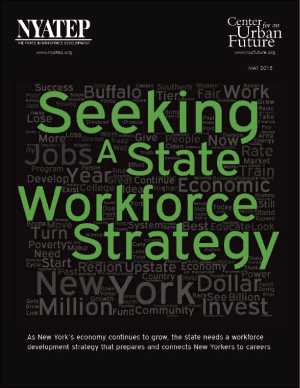On June 14, 2016, the Center for an Urban Future and NYATEP convened a symposium on how New York State can better integrate job training into its signature economic development program, the Regional Economic Development Councils (REDCs). The event featured a keynote speech from NYS Liutenant Governor Kathy Hochul and a panel discussion that included Winston Fisher, Co-Chair, NYC REDC & Partner, Fisher Brothers; Robert J. Jones, Co-Chair, Capital Region REDC & President, SUNY University at Albany; Melinda Mack, Executive Director, NYATEP; Brian McMahon, Executive Director, NYS Economic Development Council; Shelby Schneider, Director of Business Retention and Expansion, Saratoga County Prosperity Partnership; Member, NYS Workforce Investment Board; and moderator Jonathan Bowles, Executive Director, Center for an Urban Future.
New York State spends nearly $1 billion each year to economic development projects across the state through its 10 REDCs. The REDCs have been the foundation of Governor Cuomo’s job creation strategy since their creation in 2011, and this bottom-up approach to economic development has garnered praise throughout the state. Thus far, however, the 10 REDC’s have only made limited investments in job training and workforce development. At a time when so many of the state’s employers struggle to find workers with the skills they need, coupling economic development investments with investments in skills-building could arguably boost the economy. Indeed, regions with a highly skilled workforce have a competitive advantage in today’s economy.
The symposium, which was generously supported by the Working Poor Families Project, explored opportunities to better integrate workforce development into the state’s REDCs, why doing so could be beneficial both to employers and workers, and what state and local officials could do to make this change.
Welcoming Remarks
-
Melinda Mack, Executive Director, NYATEP
-
Jonathan Bowles, Executive Director, Center for an Urban Future
Keynote
-
Hon. Kathy Hochul, NYS Lieutenant Governor, Chair of the NYS REDCs
Panel Discussion: Integrating New York’s REDCs with Workforce Development
-
Moderator: Jonathan Bowles, Executive Director, Center for an Urban Future
-
Winston Fisher, Co-Chair, NYC REDC & Partner, Fisher Brothers
-
Robert J. Jones, Co-Chair, Capital Region REDC & President, SUNY University at Albany
-
Melinda Mack, Executive Director, NYATEP
-
Brian McMahon, Executive Director, NYS Economic Development Council
-
Shelby Schneider, Director of Business Retention and Expansion, Saratoga County Prosperity Partnership; Member, NYS Workforce Investment Board
This event is generously supported by the Working Poor Families Project.
The Center for an Urban Future would also like to acknowledge general operating support provided by the Bernard F. and Alva B. Gimbel Foundation, the Lucius N. Littauer Foundation and the M&T Charitable Foundation.
We are also grateful for support from Fisher Brothers for the Center for an Urban Future’s Middle Class Jobs Project and from the Altman Foundation for ongoing research and advocacy on workforce development and human capital issues.



